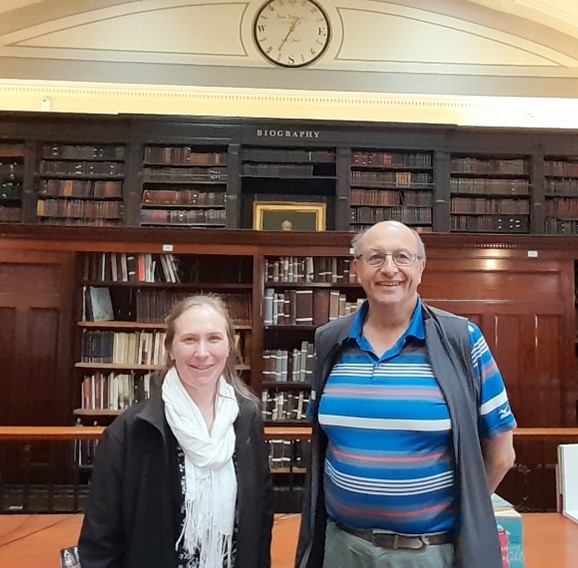Merging Small Molecule and Protein Data across Two Continents with the help of the CCDC
We talked to Professor Alice Brink from the University of the Free State, South Africa.
“I am an Associate Professor of Inorganic Chemistry at the University of the Free State, South Africa. Our research focuses on understanding the interlinkage effects of chemistry, kinetic reaction mechanisms and biological factors which affect drug development. The aim is to develop target specific radiopharmaceuticals — hit complexes containing a transition metal or radio-nuclear isotope — which can bind with high affinity and specificity, to a disease site or protein residue.”
The Role of Crystallography
“Crystallography plays a large role in our research. It allows us to unequivocally “see” our molecule, the orientation of organic function groups which are bound to the metal centre, and where our organometallic complexes may bind to a biological site either directly via metal-protein coordination or via weak organic-protein interactions. The interdisciplinary utilization of chemical and macromolecular X-ray crystallographic data (CX vs MX) is research conducted in association with Prof John Helliwell at Manchester University, UK as we try examining the driving factors behind the coordination of ‘unnatural’ organometallic complexes to proteins in a specialization related to Fragment Based Drug Discovery (FBDD).”

University of the Free State and University of Manchester joint research collaboration – Professors Alice Brink and John R. Helliwell.
“Our small molecule rhenium in protein collaboration began in 2013 in Warwick after being introduced by Prof Andreas Roodt at the European Crystallographic Meeting (ECM28). Our joint research took advantage of the tuneability of the Diamond Light Source to access the rhenium LI absorption edge and so with our home source Cu Kα wavelength our diffraction data had large differences in the rhenium scattering. This extended the sensitivity into lower occupancy rhenium binding cases. Owing to similarities, technetium chemistry is nicely modelled by use of rhenium chemistry. We also measured our complexes at both cryo and room temperatures yielding a physiologically relevant view of fragment binding.”
The Role of the Cambridge Structural Database (CSD) and CCDC Software
“The CSD, CCDC software and the PDB are the foundations that support our research. ConQuest allows us to easily search what small molecule crystal structures have been published and what structural variations are available. This assists us in ligand development when investigating new bifunctional chelators to improve the bioactivity of organometallic complexes. Our interdisciplinary research involves a large amount of cross usage of software between CX and MX to overcome the challenges of data formats which are not yet fully interoperable. Mercury plays a key role here as it allows us to convert CX to compatible MX file formats and vice-versa. Without the file conversion ability of Mercury we would not have easily succeeded in conducting research simultaneously in CX & MX field.”

Discussions held at the Cambridge Crystallographic Data Centre (CCDC), standing before the timeline showing 60 years of the CSD, its contribution to science and celebration of its founder Dr Olga Kennard. Left–right: Professor A Brink, S Ward, Dr A Mukhopadhyay.
“We also conduct regular searches using the CSD for small molecule data and the PDB for protein structures. The PDB database searches gave us complimentary data and structures we needed from earlier studies. The use of CSD-CrossMiner and Mogul assists these searches as it can quickly indicate whether our hypothesis is worth pursuing further. Our studies using “On the shelf” timelines gave insight into the chemical stability and transformations of our rhenium complexes, whereas the CSD database searches yielded up many other complexes which were pivotal in understanding details of different amino acids’ interactions to our complexes.”
Time, Energy and Resources saved by the CSD and CCDC Software
“CCDC software and the carefully collated data of the CSD saves time, energy, and resources. I still remember, as an undergraduate student, searching the journal archives in the library looking for a synthesis or structure of a possible molecule and thinking how easy it would be to miss the molecule if I did not search the book index carefully. Or experiencing frustration because the essential library book was loaned out or housed on the top shelf where vertically challenged individuals cannot reach. With the CSD it is simply a matter of defining the search and multiple results become available within seconds.”
Overcoming Challenges and Surprising Results
“CCDC software has been helpful in overcoming many challenges. Our research has observed surprising correlations when merging CX and MX data and highlights the challenges of interoperability which are still present when conducting cross-disciplinary research in the fields of chemistry, biochemistry, and drug development.”

Professor John Helliwell, Dr Madeleine Helliwell (University of Manchester) and Professor Alice Brink (University of the Free State) during a visit to South Africa. In Manchester, Madeleine was the specialist in chemical crystallography and John the specialist in protein crystallography.
Further Reading
Brink, A., Helliwell, J.R. New leads for fragment-based design of rhenium/technetium radiopharmaceutical agents. IUCrJ, 2017, 4, 283-290. DOI:10.1107/S2052252517003475.
Brink, A, Helliwell, J.R. Formation of a highly dense tetra rhenium cluster in a protein crystal and its implications in medical imaging. IUCrJ., 2019, 6, 695-702. DOI:10.1107/S2052252519006651.
Brink, A, Helliwell, J.R. Why is interoperability between the two fields of chemical crystallography and protein crystallography so difficult? IUCrJ., 2019, 6, 788-793. DOI:10.1107/S2052252519010972.
Brink, A., Jacobs, F.J.F., Helliwell, R., Trends in coordination of rhenium organometallic complexes in the Protein Data Bank. IUCrJ., 2022, 9, 180-193. DOI: 10.1107/S2052252522000665.